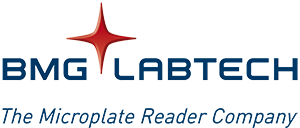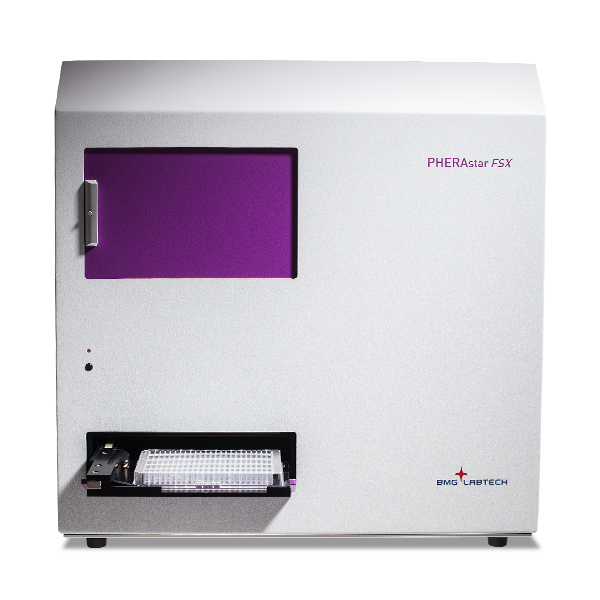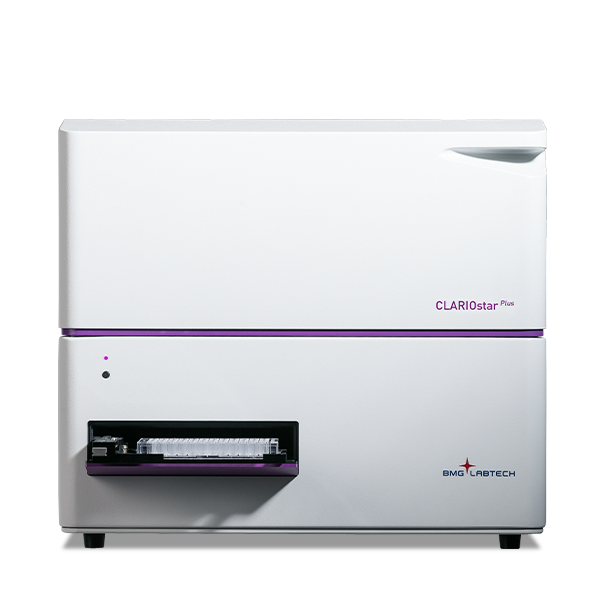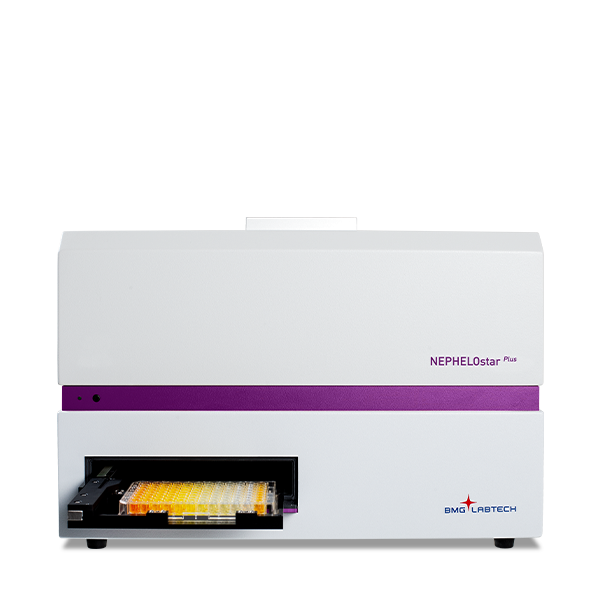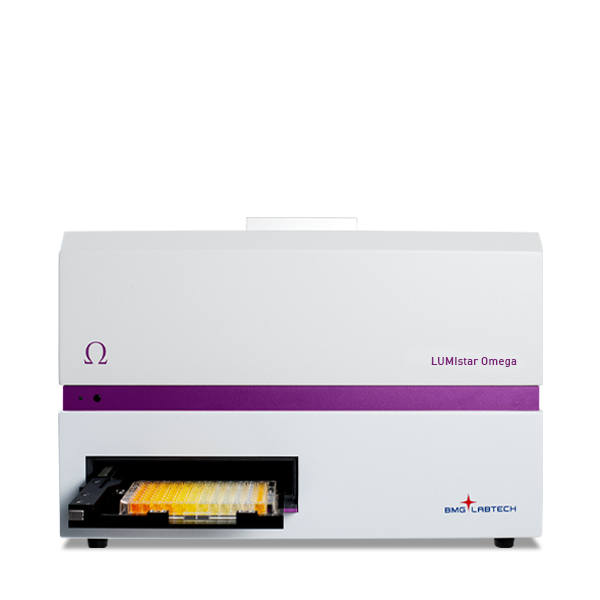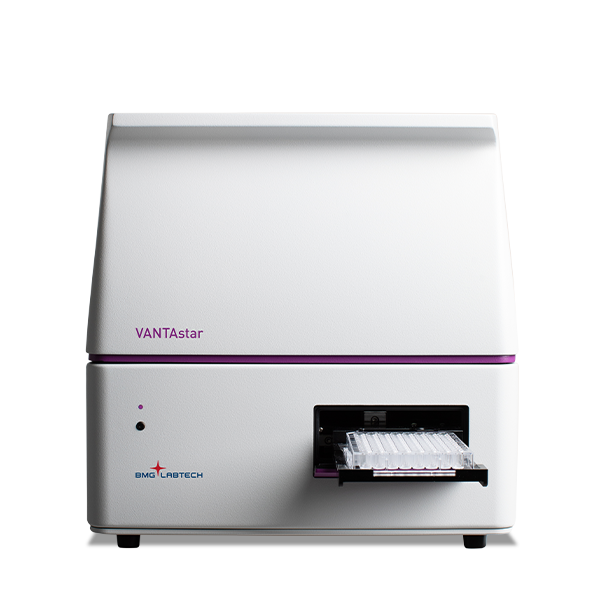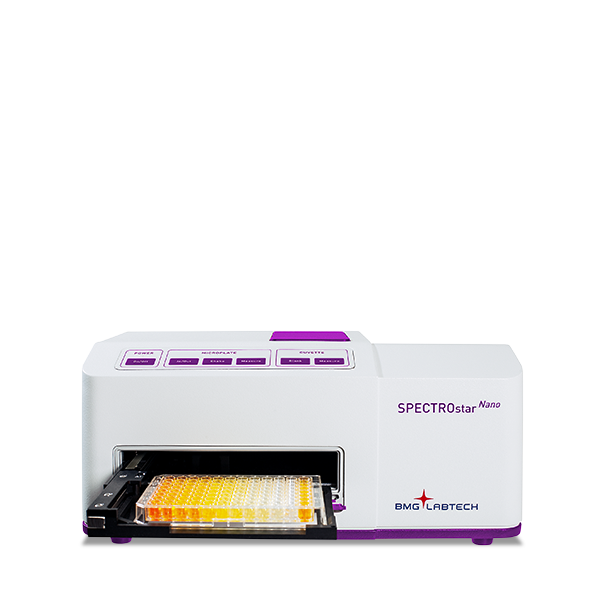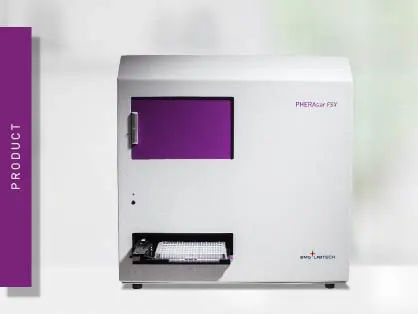
흡광도 마이크로플레이트 리더 또는 엘라이자 (ELISA) 리더는 특정 파장의 빛에 노출되었을 때 마이크로플레이트에 존재하는 액체 시료에 의해 흡수/투과되는 광자를 검출하고 정량화할 수 있는 장비입니다.
형광 및 발광과 달리 흡광도 검출은 광학 밀도(OD)의 절대 정량을 측정합니다. OD는 샘플에 닿는 빛의 강도와 샘플을 통해 투과되는 빛의 강도 사이의 대수 비율로 계산됩니다. 그래서, 샘플을 통과하는 빛의 투과도로 이용할 수 있습니다.
흡광도 마이크로플레이트 리더는 생명 과학 연구, 신약 개발 및 스크리닝, 임상 실험, 합성 생물학, 식품 또는 수질 모니터링과 같은 다양한 응용 분야에 사용됩니다.
큐벳을 이용하여 한 번에 하나의 샘플을 측정하는 일반적인 흡광도 마이크로플레이트 리더 대비 마이크로플레이트 리더는 보다 많은 샘플 수를 한꺼번에 흡광도 분석을 할 수 있습니다. 96웰 마이크로플레이트를 몇 초 만에 측정하고, 384 또는 1536웰 플레이트를 몇 분 안에 측정할 수 있습니다.
- Initial recommendation
- Detailed Recommendation

Get help selecting the right microplate reader
Configure your microplate reader and get an initial recommendation!
흡광도 마이크로플레이트 리더는 무엇입니까?
흡광도 마이크로플레이트 리더는 광학적으로 언급하게 되면 상당히 복잡한 기기입니다. 신호의 특성 때문에 광원, 수신 파장 선택을 위한 광학 장치, 디텍터 및 기준이 되는 채널이 필요합니다.
샘플은 특정 강도의 빛에 의해 조절됩니다. 샘플에 노출된 총 빛의 세기는 미리 측정된 기준 채널에 의해 측정되고, 디텍터는 광원을 기준으로 마이크로플레이트의 반대쪽에 있습니다. 샘플을 통해 전달되는 총 빛의 세기의 양과 파장을 측정되고, 디텍터를 통과하지 못한 빛은 흡수됩니다.
투과된 빛의 측정된 양은 일반적으로 특정 분자의 농도를 계산하는 데 사용할 수 있습니다. 흡수된 빛의 양은 농도와 관련이 있기 때문입니다(Beer-Lambert 법칙). 또는 표준 곡선과 미지의 농도를 계산할 수 있습니다. 이러한 방식으로 ELISA를 통해 핵산, 단백질 및 특정 분자를 정량화할 수 있습니다.
흡광도 마이크로플레이트 리더는 단독 형태, 전용 또는 다중 모드 마이크로플레이트 리더의 일부로 형광 또는 발광 측정과 결합된 형태의 모델이 제공됩니다.
실험실에서 흡광도 마이크로플레이트 리더를 사용하시겠습니까?
여기에서 좀 더 자세한 견적을 요청하십시오.

파장 선택
파장 선택 기능은 흡광도 마이크로플레이트 리더에 필수이며 사용하는 검출기 유형에 따라 다릅니다.
PMT(Photo Multiplier Tubes) 또는 CCD(Charge Coupled Device) 분광기의 두 가지 유형의 디텍터를 일반적으로 사용합니다.
PMT 기반 마이크로플레이트 리더는 광원과 플레이트 웰 사이의 파장을 선택할 수 있는 도구가 필요합니다. 광학 필터 또는 모노크로메이터는 빛이 샘플로 전송되기 전에 원하는 파장을 선택하여, 원하는 파장의 빛만 샘플에 투과되어 디텍터인 PMT에 의해 측정됩니다.
스펙트럼 또는 파장 범위를 스캔하려면 PMT 기반 마이크로플레이트 리더는 모노크로메이터가 필요합니다. 모노크로메이터는 원하는 파장을 선택하고 기계적인 움직임에 따라 순차적으로 측정합니다. 여러 개의 분리된 파장을 한 번에 측정하려면 각각의 필터를 사용하거나 모노크로메이터 스캔이 필요합니다.
CCD 분광계 기반 마이크로플레이트 리더는 파장을 선택하는 별도의 도구가 필요하지 않습니다. 분광계는 샘플을 통해 투과된 빛에 존재하는 파장을 감지하여 CCD 검출기로 도달합니다. 이것은 모노크로메이터와 달리 모든 파장의 강도를 한 번에 측정합니다.
이러한 방식으로 스펙트럼, 단독 또는 여러 개의 개별 파장 측정은 모노크로메이터 방식처럼 기계적 스캐닝이 필요하지 않기 때문에 짧은 시간에 획득할 수 있습니다.
분석 또는 응용 분야에 스펙트럼 결과를 측정해야 하는 경우, 기계적 스펙트럼 스캐닝이 필요하지 않기 때문에 CCD 분광계는 모노크로메이터보다 훨씬 빠릅니다.
호환 가능한 마이크로플레이트 종류
BMG LABTECH사 단독 및 다중 모드 기기는 흡광도 측정을 위한 UV/vis 분광계가 장착되어 있고, 220~1000nm의 전 파장 스펙트럼을 1초/웰 미만으로 측정합니다.
교반 기능과 온도 유지
흡광도 마이크로플레이트 리더를 선택할 때 연구의 특성과 분석 방법의 특성을 고려해야 합니다. 일반적으로 교반 기능과 온도 유지를 통한 반응 시간 조절은 중요합니다. 반응 시간 조절은 예를 들면 37°C에서 안정적인 온도에서 효소 분석을 실행할 때 매우 중요합니다. 다양한 쉐이킹 옵션으로 최적의 혼합 기능을 적용할 수 있습니다. 박테리아 또는 효모(OD600)의 세포 성장 분석과 같은 응용 분야의 경우 플레이트 쉐이킹은 최적의 산소 공급을 통해서 빠른 세포 복제에 매우 중요합니다.
큐벳 사용 가능
일반적으로 흡광도 측정은 가로*세로 길이가 1cm로 규격확된 큐벳을 사용합니다. 마이크로플레이트에서 빛이 투과할 수 있는 길이는 샘플의 부피와 플레이트 종류에 따라 달라집니다. 샘플이 수용액인 경우, 물의 높이를 고려하여 마이크로플레이트에서 측정을 보정할 수 있습니다. 이 옵션에도 불구하고, 큐벳을 사용하여 측정해야한다면, SPECTROstar Nano와 같은 마이크로플레이트 리더처럼, 큐벳 장착 위치 또는 LVis 플레이트와 같이 수평으로 큐벳을 측정하기 위한 플레이트 어댑터가 있는지 확인해야 합니다.
결과 분석 소프트웨어
마이크로플레이트 리더에 포함된 소프트웨어 기능을 매우 과소평가하기도 합니다. 일부 기기의 경우, 소프트웨어는 측정 과정만 제어하고 숫자로 표현된 결과만을 제공하기도 합니다. 또 다른 경우에는 복잡한 결과 분석까지 수행할 수 있는 소프트웨어를 제공합니다.
포괄적이고 사용하기 쉽고 편리한 분석 소프트웨어는 결과 분석 과정을 단순화하여 장비를 최대한 활용할 수 있도록 합니다.
흡광도 분석을 위한 가장 유용한 기능은, 백그라운값 제거, ELISA 분석 또는 Beer-Lambert 법칙에 대한 표준 곡선을 기반으로 한 농도 자동 계산, 260/280 비율, 빛의 투과 길이 보정, Km 및 Vmax와 같은 효소 상수값을 계산하는 것입니다.
BMG LABTECH사 분석 소프트웨어는 내장된 특정 프로토콜과 전용 분석 템플릿이 있어, 마우스 클릭 한 번으로 기기 수행 및 및 분석이 가능하므로 연구자가 쉽고 빠르게 실험을 수행할 수 있습니다.
![]()
결과 분석 소프트웨어
마이크로플레이트 리더에 포함된 소프트웨어 기능을 매우 과소평가하기도 합니다. 일부 기기의 경우, 소프트웨어는 측정 과정만 제어하고 숫자로 표현된 결과만을 제공하기도 합니다. 또 다른 경우에는 복잡한 결과 분석까지 수행할 수 있는 소프트웨어를 제공합니다.
당사의 모든 흡광도 마이크로플레이트 리더는 고강도 제논 플래시 램프와 CCD 디텍터가 장착되어 있습니다.
BMG LABTECH사는 흡광도 검출을 위해 필터나 모노크로메이터 대신 UV/vis 분광기를 사용한 최초 회사입니다. 고성능의 제논 플래시 램프로 샘플 조사하면 BMG LABTECH사의 초고속 UV/vis 분광계는 특정 파장 대신 전체 스펙트럼을 측정합니다. 1~10 nm의 분해능으로 220~1000 nm의 모든 파장을 웰당 1초 이내에 측정합니다.
FLUOstar Omega 모델은, 선택에 따라 필터 기반 흡광도 감지(PMT 기반)를 사용할 수 있습니다.

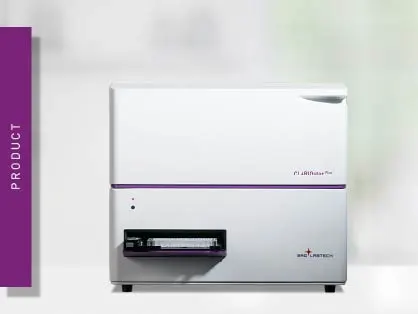
CLARIOstar Plus
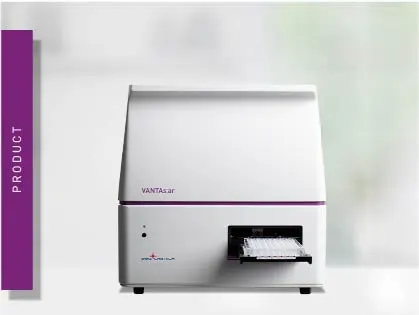
VANTAstar
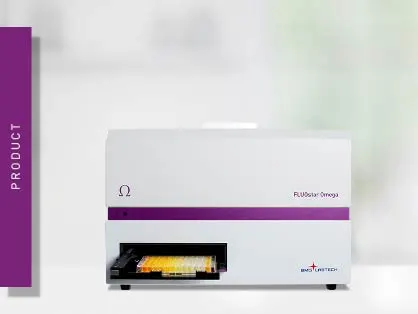
Omega Series
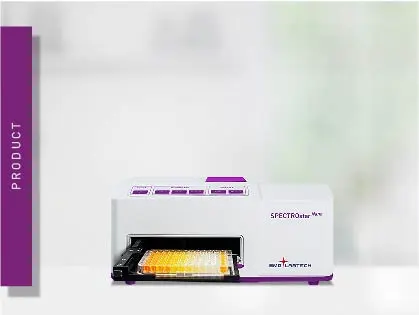
SPECTROstar Nano
흡광도 마이크로플레이트 리더로 측정할 수 있는 실험은 무엇입니까?
흡광도는 생명 과학 응용 분야에서 가장 널리 사용되는 검출 모드 중 하나로, 흡광도 마이크로플레이트 리더는 단독 또는 다양한 응용 및 분석을 할 수 있는 다기능 측정 모드로 개발된 모델도 있습니다. 여러 비색 분석법은 마이크로플레이트 리더에서 사용할 수 있도록 개발되었습니다.
가장 일반적인 응용 분야 중 하나는 260 nm에서 DNA/RNA 정량 측정입니다. 일반적으로 효소 결합 면역흡착 분석법(ELISA)에 의해 용액에서 특정 단백질을 정량 측정하는 것도 가능합니다. 단백질 정량을 위해 여러 비색 방법도 사용할 수 있으며, 자사의 블로그의 "단백질 측정: 적합한 방법 검색"에서 Bradford, BCA와 같은 단백질 정량 분석에 대한 자세한 설명과 실험 법 선택에 도움이 되는 정보를 얻을 수 있습니다.
흡광도 마이크로플레이트 리더가 측정할 수 있는 또 다른 애플리케이션은 "600 nm에서의 광학 밀도"(OD600) 또는 비색 분석에 의한 세포 생존력을 측정하여 박테리아 및 효모의 세포 성장입니다.
BMG LABTECH사의 흡광도 마이크로플레이트 리더를 사용한 측정 사례:
다음은 BMG LABTECH사 마이크로플레이트 리더에서 측정한 흡광도 측정 사례입니다.
흡광도 애플리케이션 노트의 전체 목록을 참조하십시오.

BMG LABTECH사 흡광도 마이크로플레이트 리더를 선택해야 하는 이유는 무엇일까요?
BMG LABTECH사는, 플레이트 기반 측정 기술에 대한 30년 이상의 완벽한 전문 기술을 기반으로, 마이크로플레이트 리더만을 전문적으로 생산하는 회사입니다. 실험실에서 매우 중요한 요소인, 민감도, 속도 및 사용의 편리함, 그리고 최상의 결과를 얻는 신뢰할 수 있는 장비를 제공합니다. 또한 수년간 최적의 성능을 얻도록 개발되었으며, 모든 전 장비는 독일에서 개발, 생산 및 테스트되었으며 매우 견고하고 신뢰할 수 있도록 제작되었습니다.
품질 인증 중 하나는 고객이 별 5.0점 만점에 4.7점을 준 기존 과학 플랫폼 "Select Science"의 제품 순위입니다. 마이크로플레이트 리더에 대한 사용자의 의견을 남기세요.
원하는 것만 선택하여 구입하세요.
모듈성으로 인해 당사의 모든 형광 플레이트 리더는 다양한 감지 모드를 장착하고 다양한 응용 분야를 다룰 수 있습니다. 추가 기능은 언제든지 업그레이드할 수 있어, 바로 사용하지 않더라도 선택 사양은 추후 설치가 자유롭습니다.
완벽한 서비스 및 기술 지원을 제공합니다.
최고의 고객 서비스를 제공하기 위해 노력하고 있습니다. 고도로 훈련된 담당자는 하드웨어, 소프트웨어 및 대부분의 애플리케이션 질문을 지원할 수 있으며, 복잡한 문제의 경우에는 직접 온라인 및 원격지원으로 문제를 효율적으로 해결합니다.
하나의 소프트웨어로 모두가 사용합니다.
당사의 모든 기기는 라이선스를 구매할 필요 없이 사용자가 필요한 만큼, 무제한으로 컴퓨터에 설치할 수 있는 소프트웨어를 제공합니다. 당사 마이크로플레이트 리더의 소프트웨어 무료 업데이트는 구매 후 첫 12개월입니다.
